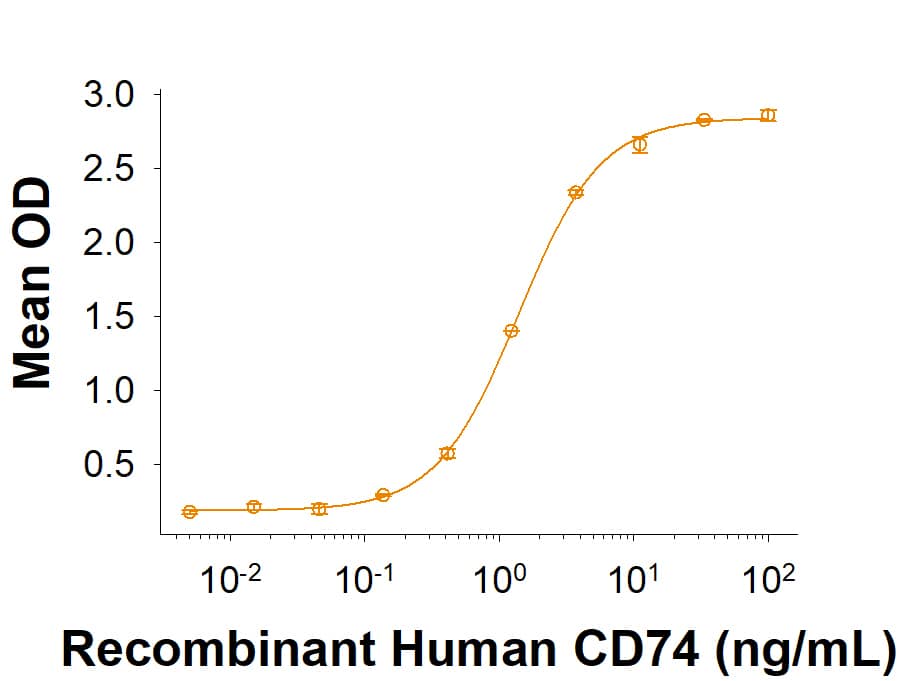Human BMP-5 Antibody Summary
Customers also Viewed
Applications
Please Note: Optimal dilutions should be determined by each laboratory for each application. General Protocols are available in the Technical Information section on our website.
Scientific Data
 View Larger
View Larger
Alkaline Phosphatase Production Induced by BMP‑5 and Neutral-ization by Human BMP‑5 Antibody. Recombinant Human BMP-5 (Catalog # 615-BMC) induces alkaline phosphatase production in the the MC3T3-E1 mouse preosteoblast cell line in a dose-dependent manner (orange line). Alkaline phosphatase production elicited by Recombinant Human BMP-5 (1 µg/mL) is neutralized (green line) by increasing concentrations of Goat Anti-Human BMP-5 Antigen Affinity-purified Polyclonal Antibody (Catalog # AF615). The ND50 is typically 6-24 µg/mL in the presence of L-ascorbic acid (50 µg/mL).
Preparation and Storage
- 12 months from date of receipt, -20 to -70 °C as supplied.
- 1 month, 2 to 8 °C under sterile conditions after reconstitution.
- 6 months, -20 to -70 °C under sterile conditions after reconstitution.
Background: BMP-5
Bone Morphogenetic Protein-5 (BMP-5) is one of at least 15 structurally and functionally related BMPs which are members of the transforming growth factor beta (TGF-beta ) superfamily (1). BMP-5 is synthesized as a 454 amino acid (aa) precursor protein that is cleaved at the dibasic cleavage site (RxxR) to release the 20 kDa C-terminal mature protein (2). Mature BMP-5 contains seven conserved cysteine residues involved in formation of the cysteine knot and the single interchain disulfide bond. Biologically active BMP-5 is a disulfide-linked homodimer of the C-terminal mature protein. Mature human BMP-5 shares 96% aa sequence identity with mouse and rat BMP-5. Cellular responses to BMP-5 are mediated by the formation of hetero-oligomeric complexes of type I and type II serine/threonine kinase receptors (1). BMP-5 is expressed by chondrocytes in proliferating and hypertrophic zones of bone growth plates (3). It contributes to limb development by promoting proliferation and differentiation of chondrocytes as well as apoptosis of undifferentiated mesoderm (3, 4). Genetic defects in BMP-5 which cause C-terminal truncation or loss of the proteolytic cleavage site result in multiple skeletal abnormalities, including the short ear phenotype in mice (5, 6). BMP-5 is also expressed by ovarian granulosa cells where it functions as an autocrine factor to promote GC proliferation and inhibit their production of progesterone (7). In the nervous system, BMP-5 promotes dendrite outgrowth and dopaminergic neuronal differentiation (8, 9). It is upregulated in oral squamous carcinoma cells and induces the apoptosis of some myeloma cell lines (10, 11).
- Chen, D. et al. (2004) Growth Factors 22:233.
- Celeste, A.J. et al. (1990) Proc. Natl. Acad. Sci. 87:9843.
- Mailhot, G. et al. (2008) J. Cell. Physiol. 214:56.
- Zuzarte-Luis, V. et al. (2004) Dev. Biol. 272:39.
- King, J.A. et al. (1994) Dev. Biol. 166:112.
- Ho, A.M. et al. (2008) BMC Dev. Biol. 8:35.
- Pierre, A. et al. (2005) Biol. Reprod. 73:1102.
- Beck, H.N. et al. (2001) BMC Neurosci. 2:12.
- Brederlau, A. et al. (2002) Mol. Cell. Neurosci. 21:367.
- Jin, Y. et al. (2001) Oral Oncol. 37:225.
- Ro, T.B. et al. (2004) Oncogene 23:3024.
Product Datasheets
Citations for Human BMP-5 Antibody
R&D Systems personnel manually curate a database that contains references using R&D Systems products. The data collected includes not only links to publications in PubMed, but also provides information about sample types, species, and experimental conditions.
4
Citations: Showing 1 - 4
Filter your results:
Filter by:
-
Expression of bone morphogenetic protein 2, 4, 5, and 7 correlates with histological activity of otosclerotic foci
Authors: Péter Csomor, Balázs Liktor, Bálint Liktor, Zoltán Szekanecz, István Sziklai, Tamás Karosi
Acta Oto-Laryngologica
-
Exploring Spatial Heterogeneity of Immune Cells in Nasopharyngeal Cancer
Authors: Aastha Sobti, Christina Sakellariou, Johan S. Nilsson, David Askmyr, Lennart Greiff, Malin Lindstedt
Cancers (Basel)
-
Serum Proteases Potentiate BMP-Induced Cell Cycle Re-entry of Dedifferentiating Muscle Cells during Newt Limb Regeneration
Authors: I Wagner, H Wang, PM Weissert, WL Straube, A Shevchenko, M Gentzel, G Brito, A Tazaki, C Oliveira, T Sugiura, A Shevchenko, A Simon, DN Drechsel, EM Tanaka
Dev. Cell, 2017-03-27;40(6):608-617.e6.
Applications: Western Blot -
BMP5 expression in the adult rat brain.
Authors: Kusakawa Y, Mikawa S, Sato K
Neuroscience, 2014-08-07;284(0):972-87.
Species: Rat
Sample Types: Whole Tissue
Applications: IHC
FAQs
No product specific FAQs exist for this product, however you may
View all Antibody FAQsReviews for Human BMP-5 Antibody
There are currently no reviews for this product. Be the first to review Human BMP-5 Antibody and earn rewards!
Have you used Human BMP-5 Antibody?
Submit a review and receive an Amazon gift card.
$25/€18/£15/$25CAN/¥75 Yuan/¥2500 Yen for a review with an image
$10/€7/£6/$10 CAD/¥70 Yuan/¥1110 Yen for a review without an image













